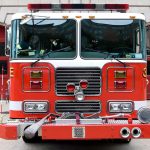When is the last time your department ran a fire pump test on your apparatus? Did you know it should be done at least once per year? Ideally, this kind of testing would be done weekly!
Amazingly, many fire departments have never tested their fire pumps and many firefighters have never operated or witnessed a fire pump performance test.
This is one mistake that can have tragic consequences. An actual fire emergency is not the time to find out if you have discharge or relief valves that don’t work, primers not working, or valves or gauges leaking.
Annual fire pump testing goes a long way toward addressing potentially life-threatening problems. The National Fire Protection Association (NFPA) fire pump testing requirements are issued with and detailed procedures for performing these tests.
The Insurance Services Office, Inc. (ISO) also requires annual pump testing, and the results help determine the fire suppression capability of your community, which will be reflected in local insurance rates.
Related Post: Is It Time For Your Annual NFPA Ladder Testing?
Preparing for Annual Fire Pump Testing
According to the International Fire Service Training Association’s (IFSTA) Pumping Apparatus Driver/Operator Handbook, there are a number of preliminary tests that should be completed prior to the annual pump test. These include:
- Verify that all fluids in the pump drive system, primer, and gear case are at the proper level.
- Verify that all pump shift controls operate smoothly, all interlock mechanisms engage properly and pilot lights are working.
- Verify that all intake and discharge valve controls are working properly and that includes the transfer valve and relief valve.
- Engage the pump and inspect pump packing or mechanical seals, and adjust or replace when necessary.
- With the pump engaged, inspect plumbing and gauge lines for leaks and verify that all gauges and instruments register accurately.
- Verify that the primer valve control and motor are functioning properly.
Once these preliminary tests are complete, you must prepare the apparatus for the pump test by following these steps:
- Maximize the length of suction and discharge lines. It is preferable to keep the operator’s panel opposite from the suction hose, with no more than 20 feet of suction hose above the surface of the water.
- Attach a strainer to the end of the suction hose.
- Attach the suction hose to the pump. Use side inlets whenever possible and avoid front suctions and rear intakes. Remove suction or piston intake valves before attaching the suction hose.
- Determine the discharge appliance, such as portable monitors or deck guns.
- Test gauges must be thread into test ports on the pump panel and calibrated within 60 days preceding the test.
- Use an RPM counter to verify the engine to within 50 RPM.
Site Selection for the Annual Pump Test
Where should the pump test take place?
- Will you test from a pressurized source or a static source?
- In-ground test pits?
- Portable tanks? Controlling water turbulence coming back into the tank while pumping at capacity can be a challenge, along with maintaining water temperature below 90(0)F.
- Mobile fire pump testing trailers?
- It is preferable to keep the water source below the pump.
- If you will be testing from a hydrant, it must be capable of flowing the rated capacity of the pump. You must allow ample space for discharging the water and add the static pressure of the hydrant to the net pump pressure.
6-Step Annual Fire Pump Testing Procedure
The annual pump test actually consists of six separate tests.
You will need the following fire pump testing equipment:
- Calibrated test gauges — intake and pressure
- Smooth bore nozzles
- Handheld pitot gauge
- Suction hose strainer
- Two 10’ sections of suction hose
- Stopwatch
- Thermometer
- Monitor
- 2 ½” fire hose
- Rubber mallet
- Tape measure
- Required spanners for hoses and appliances
Test #1: Five-Minute Vacuum Test
Run the pump vacuum for 5 minutes to begin the actual pump test.
Test #2: Timed Primer Test
This determines how long it takes to lift water to the pump so that pumping can begin. For pumps rated up to 1,250 gpm, a 30-second maximum time is allowed, and a 45-second max is permitted for pumps rated for 1,500 gpm or higher.
Test #3: 100% Test
Run the pump for 20 minutes at 100% of rated capacity, with a net pump pressure of 150 pounds per square inch (psi).
Test #4: 5-Minute Overload
The NFPA requires this test for pumps rated for over 750 gpm. Immediately after the 20-minute test, run the pump for 5 minutes, at its rated capacity, at 165 psi.
Test #5: 70% Test
Run the pump for 10 minutes at 70% capacity and 200 psi.
Test #6: 50% Test
Run the pump for 10 more minutes at 50% capacity and 250 psi.
Once the test is complete, make sure the test is properly documented. This enables you to proactively schedule repairs so that your apparatus will meet all required standards. It will also help your department earn ISO points — which helps your community enjoy lower insurance rates.
Related Post: Fire Truck Pump Safety Precautions
If you have questions about annual pump testing for your apparatus, please contact us at Jon’s Mid America.
By completing this crucial testing on schedule every year, you can rest assured that your pumps will work as needed — when they are needed most.



